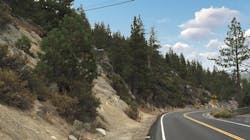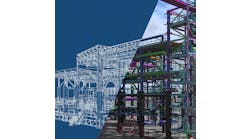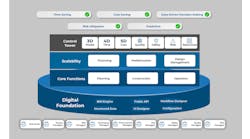By: Bill Wilson
Always ask Mom if it is OK.
Seriously, if someone is going to be trusted and depended upon, it is going to be the one who carried you around for nine months. Dale Keller, senior project manager with the Nevada Department of Transportation (NDOT), had a skeptical mother when the designs for Project Neon in Las Vegas were being worked up. A native of Las Vegas, Keller’s mother wanted to know if there would be a 3-D model of the project.
“I told her that we don’t have that anymore, it’s all virtual reality,” Keller told Roads & Bridges. “She was a little skeptical at first but once she saw what she could do with it and the different areas she could look into and zoom in and zoom out . . . she really grasped the concept.”
Virtual reality is still that new kid in class in the road and bridge industry. It is starting to make a presence, but not many know what all it has to offer. Those who are already befriending the tool use it mostly to wow the public or officials. In that sense, virtual reality is a game-changer. By strapping on the magic goggles, the technology puts you in the middle of the future, showing you exactly the project impact. But will engineers, contractors, agencies and city officials be able to use virtual reality while a project is unfolding out in the field? Will a contractor be able to look at a bridge half complete through those magic goggles and anticipate any problems? In a design-build format, when design changes are coming in at the last second, will a DOT project manager be able to use virtual reality to make sure those changes are the best solution? The verdict is still out as to the value this new world will have out in the field, but for those who are using it now in a more basic format it has proved to be invaluable.
Playing turns to work
The millennials are now in full force. More and more are entering the workplace, especially in the road and bridge industry, and are bringing their video game-sculpted minds with them. It is happening at NDOT, which went full throttle on virtual reality after a few staff members, fresh out of college, began playing around with the tool. NDOT officials then decided to use a 3-D model based on engineering accuracy—one level below virtual reality—on the first phase of the U.S. 95-215 Beltway Centennial Bowl project, which was opened to traffic this past July. The $47 million portion, which began in August 2015, included northbound and southbound U.S. 95 connection ramps to the east and westbound Beltway, respectively, and added a southbound collector-distributor road. The main feature was a 2,500-ft-long flyover linking westbound I-215 with southbound U.S. 95.
“Centennial was the first one we experimented on and started using visualizations and fly-through videos and things like that,” explained Keller. “Graphics played a great benefit for public outreach purposes.”
NDOT started internally by creating its own 3-D renderings of the project, and the effort took 2,000 man-hours to complete.
Sam Lytle, owner and 3-D visualization specialist of CivilFX, pushed the agency into full virtual reality mode. He used mapping files (AutoCad files, Microstation files, etc.) and inputted them into a computer software program to create engineering-scaled renderings.
NDOT used a VR rendering to demonstrate the limited impact of an added path on S.R. 28.
“He creates a virtual world like a video game and he develops that from scratch and he uses components from Google Earth and other programs,” explained Keller. “He pops those into whatever virtual world he creates. Once the system is created he can really tweak it and modify it based on any design changes.”
NDOT upped its visual game with Project Neon. Project Neon in Las Vegas is the largest public works project in Nevada history, and it was the first where virtual reality was implemented. The project will widen 3.7 miles of I-15 between Sahara Avenue and the Spaghetti Bowl interchange in downtown Las Vegas. Project highlights include an HOV direct connect flyover between U.S. 95 and I-15; reconstruction of the Charleston interchange; and the realignment of Martin Luther King Boulevard, which is a frontage road to I-15. (MLK is now open to traffic.)
NDOT is trying to maximize the virtual reality tool. With the Centennial Bowl project, design was only about 30% complete when the 3-D aspect was created. Project Neon was much further along in the design phase, and the flyover video they are using puts the user in a helicopter with 360° viewing. The virtual reality can be used with a tablet and an iPad, and can be accessed through the NDOT website. The helicopter tour can be downloaded to YouTube and watched with virtual reality goggles, an iPhone or an Android device.
“The first time [with Centennial] we kind of created some fly-through videos, but we were very limited as to what we could show, and the software was limited too,” said Keller. “What we are working towards is actually making it where you can have the whole virtual world uploaded to your phone.”
Virtual reality has been proven successful in the before-and-after effect. When plans called for reducing six lanes of U.S. 95 down to four (two lanes in each direction), NDOT used the tool to overlap the normal six lanes with what they called “the Big Squeeze.”
“We had a lot of questions as to how this was going to look and feel so we made this video showing how you get around the work zone, what are the merge points and everything like that,” remarked Keller.
The S.R. 28 shared-use project up in Lake Tahoe is a highly sensitive environmental area that calls for the construction of a bike/pedestrian path. NDOT used virtual reality to help convince officials and those involved of the limited impact construction would have on one of the most beautiful backdrops in the U.S.
“People ask if it is a real picture or if it is just a rendering,” said Keller. “The quality is really helpful not only for public outreach but for the engineers; when they look at it, they could say, ‘Well, that’s not quite right, that is not my intentions,’ and could make changes to the design.”
As for taking virtual reality out on the jobsite to check on progress, Keller is not sure if it is possible. According to him, other technology, like a LiDAR 360° camera in a backpack or bag, will allow the contractor to conduct asset management.
“You can take it and do it every day, every month and at different intervals and understand what has changed between the two and take cross sections of it. I see that forthcoming, especially on the contractor side.
“I don’t see [virtual reality] replacing the tool we currently have with design files or AutoCAD or Microstation, but it will be another tool that will help visualize different areas,” said Keller.
Project Neon, the largest public works project in Nevada history, is NDOT’s first go at virtual reality.
Designing in Scotland’s yard
Like NDOT, CH2M Hill’s Scotland office discovered the powers of virtual reality by literally trying it on for size. About a year or so ago the design firm obtained a couple of new headsets from HTC. The positive effect was instant.
“For several years now we produced models that you can move around and look at on a computer screen,” Gregor Simpson of CH2M Hill told Roads & Bridges. “They may look fabulous on a computer screen, but they are essentially viewed in 2-D. I think the first time anyone puts on a virtual reality headset with a decent model they are just blown away. I think it helps translate—particularly to non-technical people like a lot of our stakeholders. To be able to put a headset on so they can actually see and feel how something is going to look is absolutely powerful.”
The pop has been in full effect on the 109-mile A9 project between Perth and Inverness, which will convert the route from a single to a dual carriageway. The joint venture of CH2M and Fairhurst is designing and supervising a 26-mile portion along A9 between Glen Garry and Dalraddy. The project requires numerous junctions and bridges to be incorporated into the design with minimal or no impact on the surrounding environment, communities and businesses. The team combined its engineering design and a digital terrain model to create a single master file, with everything geo-referenced for proper modeling positioning. The file was then exported into a fully integrated, interactive 3-D reality model that was crucial for communication and stakeholder engagement throughout the design of the new A9 infrastructure.
The CH2M/Fairhurst team also hoped virtual reality would play a part in career recruitment.
“The Scottish government wants to increase levels of participation in engineering and math subjects,” said Simpson. “We’ve gone into one of the high schools along our section of the route and have carried out engagement activities with the children there. [Virtual reality] is very popular with the kids. Even just on the benefit of garnering interest, especially amongst school children who do not seem interested in a career in engineering, I think that has been growing and it has been amazing.
“It also was used at one of the public exhibitions, and people were coming from far away to experience the virtual reality model.”
A portion of the A9 project runs through a national park, so the CH2M/Fairhurst team needed to engage with the national park authority.
Virtual reality (without the goggles) was used during meetings and showed the authority how the project would look and helped trigger discussion over options.
“Without that, there is always a risk they can reject the scheme proposals, and that could cause delays to the project that could add not just months but years, depending on when we could resolve it,” remarked Simpson.
For the environmental assessment, CH2M/Fairhurst has been able to insert screen shots from a new visualization model into final reports.
Virtual reality also is being used on the A82 project in Scotland, which is another road project through a national park with huge environmental constraints, and a project involving a sculpture on a pedestrian/bicycle bridge over a couple of canals. There, virtual reality has been used on-site where the client put on goggles and saw a before-and-after on how the new bridge would look.
“The uses of virtual reality have been really beneficial,” said Simpson.
About The Author: Wilson is editorial director of Roads & Bridges.







